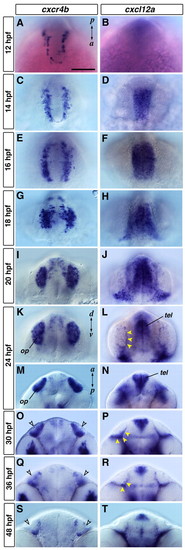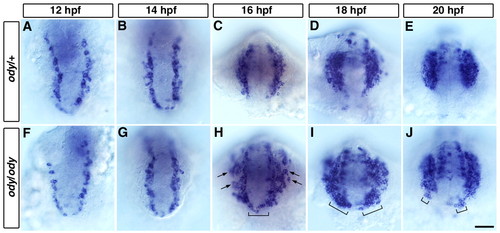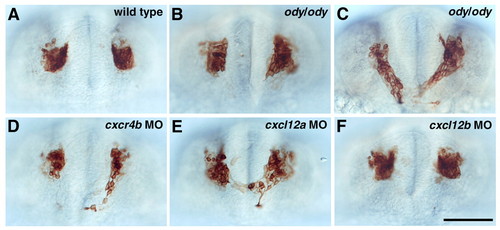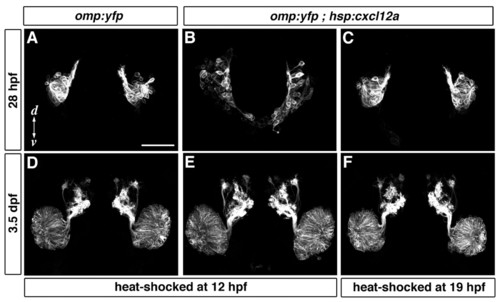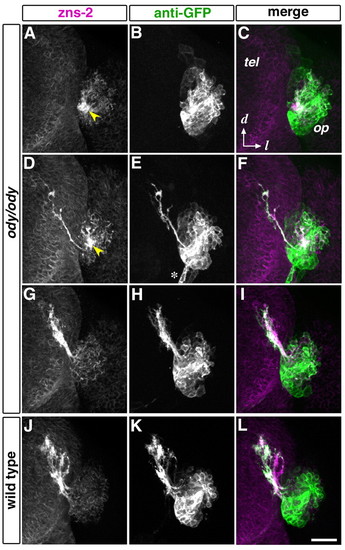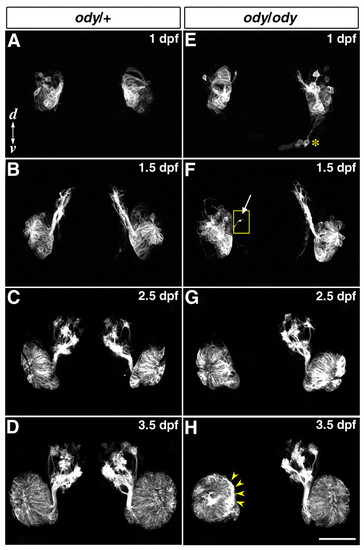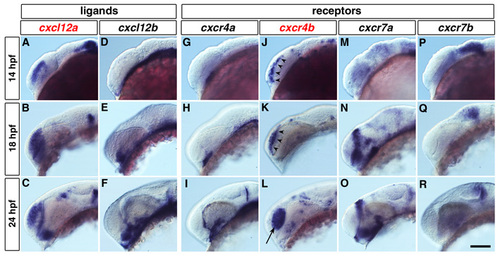- Title
-
Cxcl12/Cxcr4 chemokine signaling is required for placode assembly and sensory axon pathfinding in the zebrafish olfactory system
- Authors
- Miyasaka, N., Knaut, H., and Yoshihara, Y.
- Source
- Full text @ Development
|
Expression patterns of cxcr4b and cxcl12a during development of the olfactory placode in zebrafish. Whole-mount in situ hybridization analysis of cxcr4b (left panels) and cxcl12a (right panels) expression in the anterior head during the first 2 days of embryonic development. (A-D) Dorsal views with anterior to the bottom. (E-H) Frontodorsal views with anteroventral to the bottom. (I-L) Frontal views with ventral to the bottom. (M-R) Dorsal views with anterior to the top. (S,T) Ventral views with anterior to the top. From 12 to 16 hpf, cxcr4b is expressed bilaterally along the anterior-lateral edge of developing neural tube (A,C,E), whereas cxcl12a is expressed medially adjacent to the cxcr4b-expressing bilateral stripes (D,F). Progressive convergence of cxcr4b-expressing domains occurs between 16 and 20 hpf (E,G,I) to form the olfactory placodes. cxcr4b expression in the olfactory placode persists during initial phase of axon pathfinding (K,M,O,Q,S), although cells near the olfactory pit (arrowheads in O,Q,S) are devoid of cxcr4b expression. At the same period, cxcl12a expression is detected at the olfactory placode-telencephalon border (arrowheads in L,P,R), as well as in the anterior tip of telencephalon. Scale bar: 100 µm. a, anterior; d, dorsal; op, olfactory placode; p, posterior; tel, telencephalon; v, ventral. EXPRESSION / LABELING:
|
|
Assembly of cxcr4b-expressing cells into the olfactory placode is perturbed in ody/ody embryos. Zebrafish ody/ody and ody/+ embryos were hybridized with cRNA probe against cxcr4b. (A,B,F,G) Dorsal views with anterior to the bottom. (C,D,H,I) Frontodorsal views with anteroventral to the bottom. (E,J) Frontal views with ventral to the bottom. At 12 and 14 hpf, the arrangement of cxcr4b-expressing cells in ody/ody embryos (F,G) is indistinguishable from that in ody/+ embryos (A,B). At 16 hpf, cxcr4b-expressing cells in ody/ody embryos disperse laterally (arrows in H) and anteroventrally (bracket in H) away from the lateral edge of developing neural tube. At 18 hpf, substantial numbers of cxcr4b-expressing cells are mispositioned ventrally (brackets in I). By 20 hpf, some cxcr4b-expressing cells (brackets in J) fail to join a cluster positioned at the correct site of the olfactory placode. Scale bar: 50 µm EXPRESSION / LABELING:
|
|
Cxcl12a/Cxcr4b signaling is required for olfactory neuron positioning. Wild-type zebrafish embryos (A), ody mutants (B,C), cxcr4b MO-injected embryos (morphants) (D), cxcl12a morphants (E) and cxcl12b morphants (F), which all carry the omp:yfp transgene, were stained with anti-GFP antibody at 24 hpf to visualize olfactory neurons. All panels show frontal views with ventral to the bottom. Two representative ody/ody embryos with mild (B) and severe (C) defects in olfactory neuron positioning are shown. Scale bar: 100 μm. PHENOTYPE:
|
|
Ubiquitous misexpression of Cxcl12a perturbs olfactory neuron assembly but does not affect projection of olfactory axons. omp:yfp/+ and omp:yfp/+;hsp:cxcl12a/+ zebrafish embryos were heat shocked at either 12 or 19 hpf. Using confocal microscope, positioning of olfactory neurons and subsequent projection of olfactory axons were viewed in the same individuals at 28 hpf (A-C) and 3.5 dpf (D-F), respectively. Composite images generated from a series of optical sections are shown. Heat induction of Cxcl12a at 12 hpf (B), but not 19 hpf (C), perturbs assembly of olfactory neurons. Heat shocking itself does not affect the positioning of olfactory neurons (A). None of the Cxcl12a heat-induced embryos display an impaired projection of olfactory axons at 3.5 dpf (D-E). All panels show frontal views. Scale bar: 100 µm. d, dorsal; v, ventral. PHENOTYPE:
|
|
Localized Cxcl12a misexpression displaces olfactory neurons ventrally. Confocal z-stacked images of zebrafish embryos labeled with anti-GFP (green) and anti-DsRed (magenta) antibodies. All panels show frontal views with dorsal to the top. (A) omp:yfp/+ embryo injected with phsp:mDsRed. Mosaic expression of mDsRed (magenta) does not affect positioning of YFP-expressing olfactory neurons (green). (B-D) Three examples of omp:yfp/+ embryos injected with phsp:cxcl12a-mDsRed. YFP-expressing olfactory neurons do not coalesce into a compact cluster. Some neurons (brackets and arrow) are found at positions close to the ventral ectopic sources of Cxcl12a-mDsRed (arrowheads). By contrast, no olfactory neurons are displaced to positions near the dorsal ectopic sources (open arrowheads). Scale bar: 100 µm. |
|
Zebrafish ody mutant embryos show OSN axon projection defects. (A-D) Axon trajectories from both ciliated and microvillous OSNs are labeled at 3 dpf by whole-mount immunohistochemistry with anti-PCAM antibody, and are shown in frontal views as z-stacked images. ody/ody embryos are classified into three groups according to the severity of axon pathfinding defects (B-D): class 1 (8 of 18 embryos), a virtually wild-type projection pattern; class 2 (5 of 18), unilatetal projection defects; class 3 (5 of 18), bilateral projection defects. Projection patterns of all ody/+ embryos (n=15) fall into class 1. Asterisks in A indicate neuromasts in the lateral line system. Scale bar: 100 µm. d, dorsal; ob, olfactory bulb; oe, olfactory epithelium; v, ventral. EXPRESSION / LABELING:
PHENOTYPE:
|
|
Projection of pioneer axons is impaired in zebrafish ody mutant embryos. ody/ody;omp:yfp/+ (A-I) and omp:yfp/+ (J-L) embryos double labeled with zns-2 antibody (A,D,G,J; magenta in C,F,I,L) and anti-GFP antibody (B,E,H,K; green in C,F,I,L) at 1.5 dpf are shown in frontal views as z-stacked images. Projection patterns of pioneer axons in ody mutants vary, ranging from no axon reaching the presumptive OB (A-C) to an essentially normal projection (G-I). Note that projection defects with intermediate severity are observed (D-F). Arrowheads indicate accumulated zns-2-positive axons near the placode-telencephalon border. Scale bar: 50 µm. d, dorsal; l, lateral; op, olfactory placode; tel, telencephalon. The asterisk in E marks mispositioned olfactory neurons. PHENOTYPE:
|
|
Live imaging of axon projection in zebrafish ody mutant embryos. Developmental processes of axon projection in representative ody/+;omp:yfp/+ (A-D) and ody/ody;omp:yfp/+ (E-H) embryos are shown in frontal views. Yellow-boxed inset in F is shown at high gain to reveal faint axonal fibers. In the ody/ody embryo, pioneer axons extending toward the presumptive OB (arrow in F) from one of two olfactory placodes are significantly reduced in number at 1.5 dpf, when compared with those from the contralateral placode and ody/+ placodes. When pathfinding by the pioneer axons is significantly impaired at 1.5 dpf, following OSN axons fail to exit the olfactory placode and eventually accumulate within the OE at 3.5 dpf (yellow arrowheads in H). The asterisk in E marks mispositioned olfactory neurons in the ody/ody embryo. Scale bar: 100 µm. d, dorsal; v, ventral. PHENOTYPE:
|
|
Expression patterns of chemokine ligands and receptors during olfactory placode assembly. Embryos hybridized with probes against cxcl12a (A-C), cxcl12b (D-F), cxcr4a (G-I), cxcr4b (J-L), cxcr7a (M-O) and cxcr7b (P-R) are shown in lateral views with anterior to the left. Arrowheads (J,K) and arrows (L) indicate the expression of cxcr4b in the olfactory placodal field and the olfactory placode, respectively. Scale bar: 100 μm. EXPRESSION / LABELING:
|

